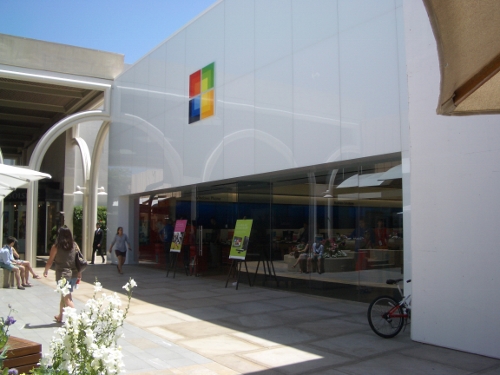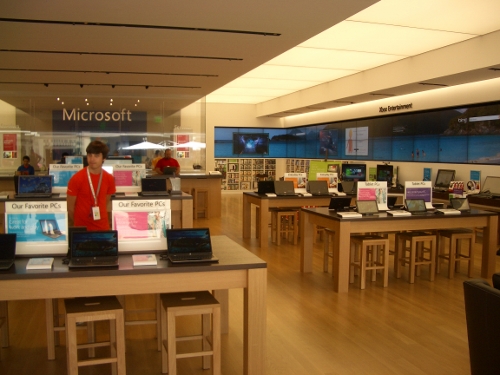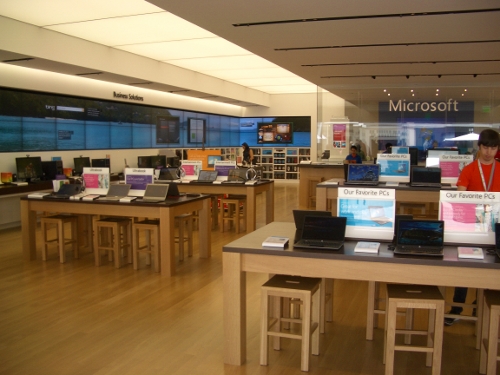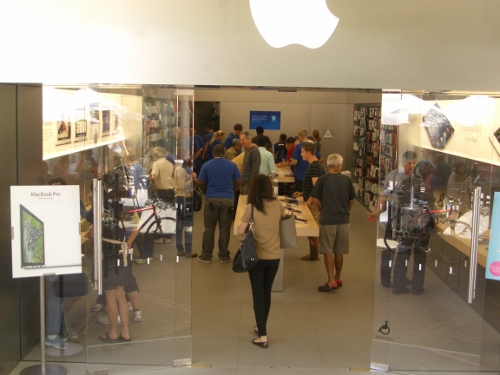I wrote this story in 2012.
Now, in 2016, as I contemplate my shift to Win10, I'm amused at the thought that I dis-ed the rock-solid Win7 here.
Last week (May, 2016) at Stanford as Professor Olaf Sporns (of Connectome fame) was lecturing to a packed audience, Microsoft servers tried to do their usual forced update to his laptop. His powerpoints came to a screeching halt, as his SRO audience groaned.
I'm waiting to see what Microsoft's business customers do — the ones they really care about — and whether and when they upgrade to Win10 from the (now venerable) Win7.
I have a few old friends who work for the Evil Empire (in research) — so I always dis Microsoft less than it deserves. (Besides, Bill Gates' name is on the Stanford Computer Science building — and the Paul Allen Center for Integrated Systems is close by. Both Bill and Paul do great philanthropy.) But, as I note below Bill himself gets frustrated by Microsoft's software.
And so my 2012 story begins. (All this is still true and, as usual, ahead of its time. I wrote this a year before Steve Ballmer's unsurprising departure. Microsoft stock had been dead money for years, as the brontosaurus of software stumbled along.) ...

The beautiful Microsoft Store at Stanford Shopping Center (2021 update: gone!)
Here's what prompted this story. Every four years ( two ticks and two tocks of the Intel clock that tracks Moore's Law), I buy a new desktop tower. For the past 15 years these have all been Intel machines running Windows. I jumped ship from Apple Macintosh after the 1984 to 1996 epoch when it looked like Apple was being thrust (by MSFT) into bankrupcy. (I had owned $100,000 in Apple stock in January 1984 when the Mac was introduced, which I sold a month later when to my great surprise it didn't skyrocket immediately. I had previously been wowed by a demo of a Xerox PARC Alto and Dorado from which the Mac was cloned.
For the past ten years I've used Windows XP on several computers of various types. I and the rest of the world got comfortable with it. So, we weren't about to change when the bloated miscarriage VISTA arrived, and we just prayed that the Redmond wonks would get it right when Win7 finally arrived.

But here the store has no customers.
Win7 is a big improvement over VISTA, as many others have remarked, and I am beginning to enjoy its features and its improvements over WinXP. Win7 is far more stable than WinXP and the interface is good. I especially like the new Taskbar.
MSFT is always on its safest, most innovative ground, when it just copies whatever has worked for Apple. The crowning example, of course, was their emulation of the Mac OS in the 1990s that led to the notorious look and feel trial, which almost resulted in Apple's demise. Substituting lawyers for engineers works for a while.
(Addendum: June 2012: MSFT just announced its new Surface tablet. That night TV comic Conan O'Brien quipped: "Yeah, Surface - that's a great name - a nice flat surface to set your iPad on.")
Win7 is a big improvement over VISTA, but that still does not let MSFT off the hook. I had to endure plenty of frustration before stooping to write this story.
I had considered writing to friends at MSFT to find out what's troubling the company. But then I decided to just do a search. It came as no great surprise that the internet is overflowing on that topic. For example, this well-documented article appeared in Fortune in 2011: Microsoft's "Office:" Why insiders think top management has lost its way. The exit interviews of MSFT employees are especially telling.
And, another Fortune article from 2011 that focused on CEO Steve Ballmer — The problem with Microsoft... (I hesitate to blame a company's misfortunes on the judgment of one CEO — there are usually other systemic and competitive landscape issues (and this also applies to HP, which I take to task below. Besides, that last article accuses Steve Ballmer of devoting too much time to Windows and Office.))
As I struggled with each impediment, I wondered are they listening to their customers? I had always imagined that MSFT must have battalions of engineers observing users sitting down for the first time setting up a computer running their latest operating system. Somehow that information must occasionally get lost. (Even Bill Gates, himself, gets frustrated by Windows Usability going backwards as Bill himself states in this priceless 2003 email.)
Through the years I've learned the drill. When setting up the new computer with a new OS, it's essential to have the old computer connected to the internet. That way you can be guided by the experiences of thousands of others who have struggled with the same issues. These are typically online forums comprised of users, some of whom are quite expert. Notable by their rarity in my experience are actual MSFT developers. Why aren't they providing the answers, rather than depending on customers? (If a computer science PhD (me) can't solve these problems, what hope does a beginnner have?) (For any problem I encountered, there are scores of others who have had the same problem. I just don't understand why these problems weren't nipped, pre-release by MSFT, or at least, why they're not addressed definitively and apologetically post-facto.)

Wait! There is one customer at the very back.
Here are two examples of problems I had that are still unresolved.
1) After working 16 hours a day for a week to get my system set up, I had several files that could not be erased and an important program that would not run. I hated the thought of continuing to build the system on a corrupted base. Therefore, i tried to do a system restore from my manufacturer-supplied restore disks. The restore disk worked, but after I entered my product key for Win7, somehow the system would not accept my brand new login name and password that I had just entered a few screens back. Hours on the phone with my computer manufacturer were insufficient to solve that problem.
2) Today (21st day of the struggle), just for fun, I tried to use the repair disc/ restore system option that is now built into Win7 to back up my existing, now working system. More hours of struggle - I was never able to restore my system from a system image written to a USB drive. Even though the drive is visible in the BIOS, the Win7 Repair Disc cannot see it. This MSFT-sponsored forum is typical: lots of confused users but no experts and no answers.
Those two problems were the most vexing, but there were perhaps a dozen other design issues that I won't drag you through.
CLONE my entire hard drive onto other hard drives that I keep in various bank vaults. (Some of my friends are head freezers - it's the same trick applied to your bio brain.)
(I use Acronis True Image for cloning (a free version is available for Western Digital (WDC) drives).) I only use the WDC drives for back up - all my working drives are SSDs (solid state drives): two Samsungs and an Intel SSD. Rotating drives are for museums. Then, I use these hard drives as check points which I can retreat to, if I encounter system problems. This method saved me from both the problems above. (But, some users who can't afford all those hard drives might just be tempted to use Time Machine on their Macs - it works.)

This photo and the one below are of the Apple Store at Stanford Shopping Center. It's immediately adjacent to the Microsoft Store. I took these photos at the same time as the ones above. I believe Larry Page's explanation to Charlie Rose of Apple's success: "You just turn it on, and it works!"
Don't get me started on Windows Live Mail or Office 2010. Windows Live Mail — this is the newish version of Outlook Express. I've tried to stay away from the bloatware Outlook. (I use TheBrain to keep track of everything I need to know.) In both Live Mail and Office 2010 essential commands are too often tucked away in hard-to-find submenus, obscured by clouds of minutiae. Bad for users but great for HCI courses in how NOT to design user interfaces.
An old habit of mine, left over from my stock trading days, is flipping on CNBC when the market is open. The securities analysts and traders, of course, abound with theories about why MSFT is stuck in neutral. The Fortune article above has the ring of truth. Whether it's a government or a corporation, if management is defective or if there are system issues, it affects everybody.
(An even more egregious example in my community is Hewlett Packard, once the darling of Wall Street, now a staggering, headless zombie – Bill and Dave deserve better.)
I just saw Larry Page (Google co-founder and CEO) do a first time interview with Charlie Rose. Charlie (who is a great Apple fan) asked him about the explosive popularity of the iPad. (The iPad has little appeal to me - its screen is too small and besides, real computers have keyboards. I use six monitors in my office.) Larry said you just turn it on and it works! Boom - the explanation. Millions of people just want to surf the internet and read their email without having to contend with error message 37 or requires administrator status or password not recognized or MBR corrupted, ad nauseum. That's why MSFT stock has been stuck in neutral despite their monopolistic history and billions of dollars in inertial revenue from corporate IT budgets. Meanwhile, Apple stock has gone through the roof.
There can be no more telling evidence than the photographs in this article. I took these photos simultaneously at Stanford Shopping Center. A wall separates the Microsoft Store from the Apple Store. It makes it easy to do a quick popularity survey. The Microsoft Store is deserted. The Apple Store is overflowing with customers.

The Apple Store is constantly filled with customers. Don't they know that Apple computers cost a lot more money? Why don't they just go next door?
(The Kinect display at the MSFT store is cool, but I credit Kinect to developer Johnny Chung Lee - now at Google.)
Another telling anecdote: I buy my WDC hard drives and SSDs from Amazon. When I ordered one last week and it didn't ship immediately I called customer service. Amazon customer service comes on live within five seconds! (That's 911 speed.) Then, a very intelligent, helpful agent located in Washington tackles your problem, and continues day-after-day to stay on top of it until it's resolved. My simple message to MSFT is to please listen to your customers: make yourselves available on the net and fix users' complaints. The gap between Amazon and its Redmond neighbor is as wide as Puget Sound. And somewhere in Heaven, Steve Jobs is smiling.
Addendum (July 2012): Kurt Eichenwald (a Contributing Editor) has published an article in the August 2012 issue of Vanity Fair on Microsoft's Downfall.
Addendum (September 2012): Lest you think I'm just bashing the Evil Empire, I did just buy a new Sony VAIO T Series Ultrabook at the Microsoft Store pictured above. I was quite tempted to buy a MacBook Air next door, but I dreaded network incompatilities with my many Windows machines. Also, the Sony alone, among 3 lb. ultrabooks, had ports for ethernet, VGA, and HDMI. It was also 500 bucks cheaper than an AIR.
Addendum (May 2013): Unfortunately for consumers and investors, MSFT continues to stumble. See this recent article on Windows 8. (If you use Windows XP, I heartily recommend an upgrade to Win7, but certainly not to Win8. Also, buy an extra SSD , so you can back up your entire system. Then, you can easily restore it after it crashes - it will.)